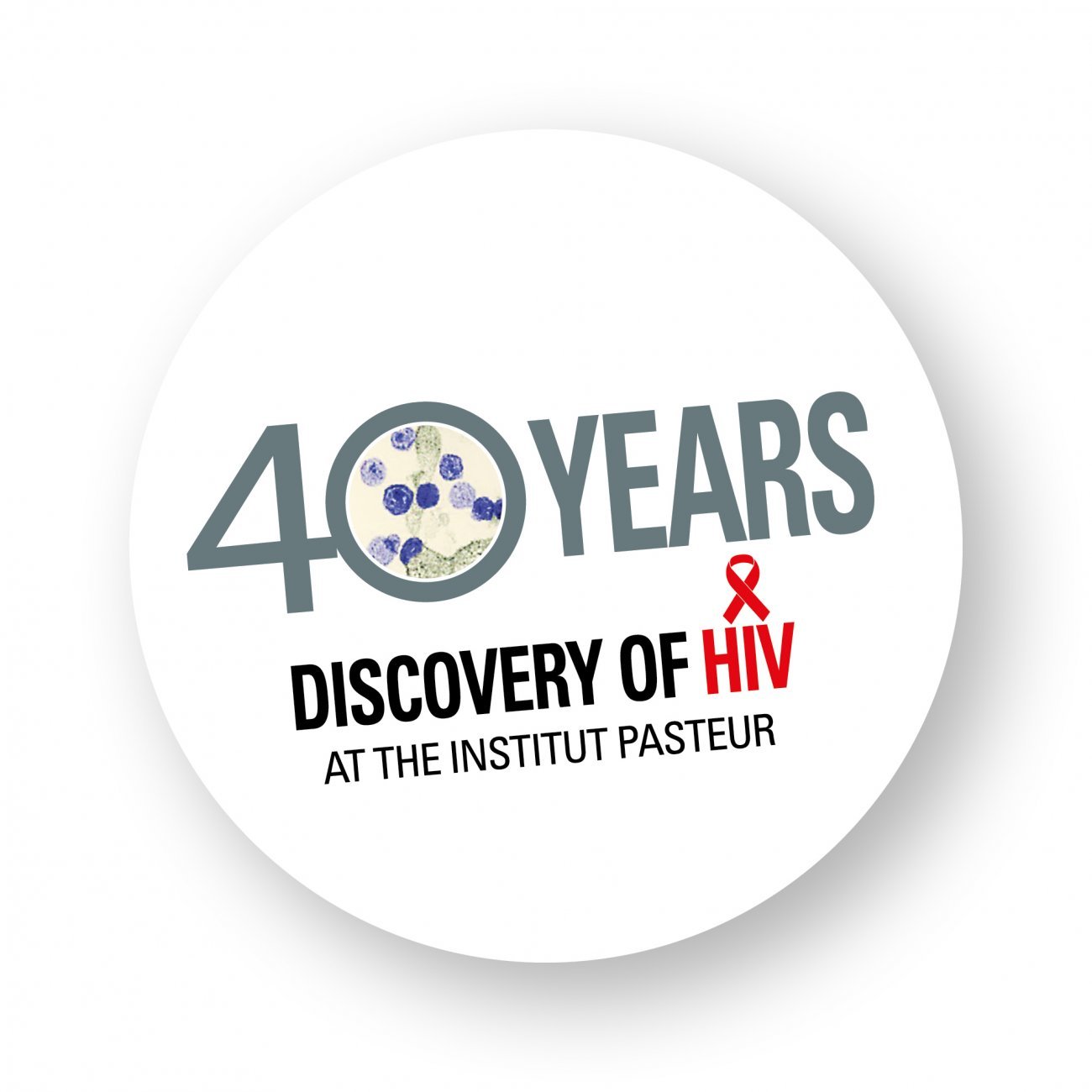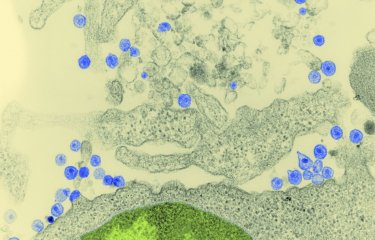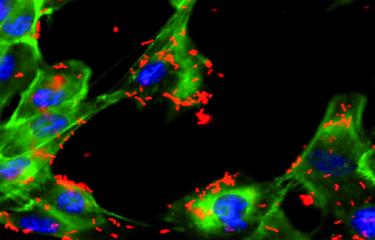African green monkeys are able to live while being infected with the simian immunodeficiency virus (SIV) without ever developing AIDS. Their hint? Directly eliminate infected cells, without causing an inflammatory reaction that the virus could use to its advantage.
|
This article is the first in a series devoted to the hopes of HIV-AIDS research, on the occasion of the 40th anniversary of the identification of the virus. |
 The immune system is composed of an army of immune cells, all very different from each other. There are B cells, which produce antibodies, CD8 T cells, CD4 T cells, and then there are cells belonging to the body’s first line of defense, like macrophages and NK cells. In humans, all these cells spring into action to try to control and eradicate HIV – very often in vain. But it seems that NK (natural killer) cells are naturally predisposed for this task. These innate immune cells are able to control simian immunodeficiency virus (SIV) – the virus that gave rise to human immunodeficiency virus (HIV) – in some species of monkey.
The immune system is composed of an army of immune cells, all very different from each other. There are B cells, which produce antibodies, CD8 T cells, CD4 T cells, and then there are cells belonging to the body’s first line of defense, like macrophages and NK cells. In humans, all these cells spring into action to try to control and eradicate HIV – very often in vain. But it seems that NK (natural killer) cells are naturally predisposed for this task. These innate immune cells are able to control simian immunodeficiency virus (SIV) – the virus that gave rise to human immunodeficiency virus (HIV) – in some species of monkey.
Tracking african green monkeys
It was while investigating African green monkeys that virologist Michaela Müller-Trutwin, now Head of the Institut Pasteur’s HIV, Inflammation and Persistence Unit, revealed the underestimated potential of NK cells. It all began in the 1990s, when the young scientist was working at the Institut Pasteur de Bangui in the Central African Republic, then with the Institut Pasteur de Dakar in Senegal and the Pasteur Center in Cameroon. «I started studying the different HIV variants circulating in Central Africa – this research was crucial for developing PCR tests for viral load measurement and searching for a vaccine that would be effective against all variants – and I then turned my attention to the animal reservoir of HIV-1 to gain a better understanding of the origin of HIV-1» explains the scientist. «After that I focused on African green monkeys, the largest SIV reservoir in Sub-Saharan Africa.»
Viruses that originated in monkeysWe know of two types of HIV: HIV-1 and HIV-2, both derived from viruses found in African monkeys (SIV or simian immunodeficiency virus). HIV-1 is the more prevalent type and is found in every world region. HIV-2 is less virulent and less transmissible than HIV-1. It is more often found in West Africa and some other countries including Angola, Mozambique, India, Brazil and Cuba. |
And for Michaela this begged the question: why are African green monkeys persistent carriers of SIV but never develop AIDS? After designing suitable immunological and genomic tools, her research led to an important initial observation in understanding HIV infection in humans. Monkeys that never develop AIDS have no signs of persistent inflammation. «We discovered that the virus replicates to high levels in the blood but does not cause chronic inflammation, unlike what happens in humans. The monkeys that stay healthy are those that manage to protect themselves from inflammation», describes Michaela Müller-Trutwin. The scientists then demonstrated early on that limiting the intensity of inflammation in primary HIV infection reduces the risk of progressing toward disease.
Highly protected lymph nodes
Another observation made in African green monkeys was that the virus is present in large quantities in the blood but generally not found in the lymph nodes. «I was struck by the idea of a tissue-specific control mechanism» marvels Michaela Müller-Trutwin. «It seemed completely paradoxical and hard to believe at first, until a strong viral control in lymph nodes despite high levels of virus in blood was confirmed in another monkey species, sooty mangabeys, where HIV-2 originated.» The scientists pursued their research further and observed that the virus entered the lymph nodes and then stopped replicating. It was as if the monkeys were allowing the virus to circulate in their blood but were able to control viral replication in the lymph nodes, a place where HIV normally hides in humans, and is hard to control even in people receiving treatment.
But what was the explanation for this remarkable feat in green monkeys? How were they able to control SIV so effectively in the lymph nodes? The virologist set out to uncover what was behind this formidable defense system, and after 15 years of research her team put the finger on it: the key are NK cells. «We didn’t think of NK cells straight away because they are part of the innate immune system», recalls Michaela Müller-Trutwin. «We thought they played a role at the beginning of the infection, before the adaptive responses kick in, and not as much in the chronic phase. We also knew that NK cells are normally scarce in lymph nodes.
Moreover, we didn’t expect that innate responses could play such an important role by their own in primates.» But they do – NK cells are indeed capable of recognizing and killing infected cells in lymph nodes, especially in B cell follicles, the primary HIV reservoir in humans. This was a «holy grail» for Scientists.
3D reconstruction of SIV-infected CD4 cells: viruses appear in red, cell nuclei in grey, and CD4 receptors in green. Copyright: Institut Pasteur/Nicolas Huot
Stimulating NK cells to tackle HIV
The results of this major discovery were published in 2017 5. «It was an important discovery for scientists working on a cure for HIV/AIDS, as one goal consists in finding a way of reducing viral reservoirs in the lymph nodes, especially in B cell follicles», emphasizes Michaela Müller-Trutwin. Other research by the Institut Pasteur team revealed that in pathogenic infection, NK cells are often unable to complete terminal differentiation and are therefore incapable of effectively killing infected cells, unlike in the natural simian host. «This is a recent concept that is currently being investigated. In the natural simian host, we have shown that NK cells evolve and differentiate during infection: their capacity to recognize and kill cells infected by SIV improves with time during the infection. We think that this adaptation is also related to their stage of maturity», explains the scientist.
«We have long known that NK cells play a very important role in immunity, but now we have discovered that they are capable of entering B cell follicles and responsible for tissue-specific control. The fact that these capacities are adaptable opens up a whole new avenue for immunotherapy that we were unaware of before», says Michaela Müller-Trutwin. In 2021, a preclinical trial in antiretroviral-treated rhesus macaques, animal models for HIV/AIDS, showed that stimulating NK cell differentiation using interleukin induced adaptive NK cell activity and reduced the viral reservoir in lymph nodes. A clinical trial (RHIVIERA01) led by two clinicians and Institut Pasteur scientist Asier Sáez-Cirión will start at the Institut Pasteur in 2023 to assess the extent to which better education of NKcells can help people living with HIV who started treatment early to achieve remission.
Read the Press Document "40 years after the discovery of HIV"





